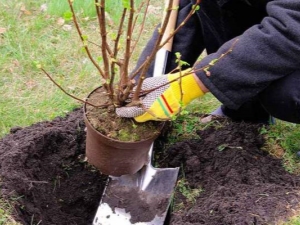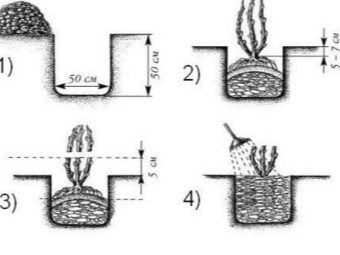Rules and features of planting gooseberry in the fall

The use of fruits and berries has a beneficial effect on human health, therefore, if there is such an opportunity, it is worth growing these crops yourself. Gooseberry is famous for a whole set of useful properties and qualities that ensure the normal functioning of the body and help it cope with various problems. To have in the country as much as possible productive gooseberry bushes, you need to know the rules and features of its planting in the autumn season.
Advantages and disadvantages of autumn planting
Such a culture as gooseberries can be planted in autumn and spring, but the first option has much more advantages. Several points can be attributed to the main advantages of such a landing of gooseberries.
- The presence of a large selection of seedlings with open roots, which makes it possible to choose the most healthy shrub without damage and disease.
- Lack of care for the bush after landing. All you need to do in advance is to prepare the pit in order to quickly place the bush in a new place and water it well. All the rest will be done by nature itself.
- A good percentage of survival rate. Autumn planting contributes to the active development of the root, and not the growth of leaves, so the bush has time to take root for winter and well restores function in the spring.
In addition to the advantages, there are some drawbacks in the autumn planting as well:
- the risk of freezing, which occurs with rapid temperature changes;
- the possibility of damage by rodents, which are especially active in the autumn.
The advantages are more than disadvantages, therefore, choosing the time when it is better to plant gooseberries, it is better to stay in the fall.
Selection of planting material and its preparation
To get a good harvest, it is important to plant healthy and strong plants. When buying gooseberry seedlings, you need to pay attention to:
- age indicators: the bush should not be older than two years of age;
- the presence of a well-developed root system, which will have 3 main roots and a large number of fibrous roots;
- the length of the ground part of the seedling should be at least 30 cm, and not higher than 40 cm.
When the seedling is selected, it is necessary to properly plant it, for which:
- all leaves are removed from the sapling;
- cut dry roots;
- the roots are immersed in the clay mixture.
After all the activities, gooseberry seedlings are ready for planting.
Saplings
When preparing the seedling for planting, it is necessary to examine it well and remove all problem areas where rot can occur. The color of the shoots and leaves, if any, should be uniform, without spots. Before the planting itself, it is necessary to sustain the plant in a growth stimulator, after which the root system is additionally protected by a clay bump that prevents the roots from drying out.
Cuttings
You can carry out the process of reproduction of the bush with the help of cuttings. If live, green branches are used, then they are planted in the ground in the summer, so that there is time for rooting. If the work is done using woody cuttings, then the landing is shifted to the middle of autumn. The choice of breeding options is not always dependent on the desire of the gardener, sometimes it is dictated by the plant variety.
For gooseberry European breeding is better to use cuttings, and for hybrids - cuttings, both green and woody.
How to choose a place and prepare the ground?
To gooseberry fruit and gave a good harvest, it is important to find a suitable place for him. On the ground, where the crop will be planted, should grow legumes, beets or potatoes, which will contribute to a good fertilizer of the soil. Planting bushes near the currant is not worth it, since they suffer from the same diseases, and this can be disastrous for both shrubs. As for the choice of location, the location between the trees will not be the best, as the gooseberry will not receive the proper amount of light.
Preparing the soil for planting, the first thing you need to free it from weeds, if possible, and remove their roots.The presence of other plants prevents getting moisture and fertilizer to the full. When the soil is prepared, a hole must be dug. Such work must be done in advance so that the earth becomes denser, and the bush does not subside after planting. For spring planting, the pit is dug out in the fall and filled with fertilizer completely. The optimum depth and width of the pit will be 50 to 50 cm. Depending on the quality of the soil, you need to make it fertilizer:
- about 10 kg of humus or manure, which is already pereprelya;
- 50 g of double superphosphate or 100 g of ordinary;
- 40 g of potassium, no more than two glasses of wood ash.
The top layer of the ground dug out of the hole is mixed with these fertilizers and placed back to prepare the soil for planting gooseberries. Transplantation to a new place should be prepared carefully and in advance, which will ensure proper results and good harvest in the future.
Seating layout
If it is necessary to plant gooseberries in the country, there are several seating schemes for this, each of which has its own characteristics and can be used in certain cases. There are such options:
- sparse;
- combined;
- landing between the rows.
To determine the most appropriate way to plant a crop, you need to know the differences between each of the options for the scheme.
Sparse
The sparse pattern of planting gooseberries involves planting bushes in one row so that there is at least one and a half meters between them, and leave a row two meters wide from row to row. Since this culture is perennial, then after 3-4 years instead of bushes, solid gooseberry walls will grow at a certain distance. This option is convenient for those who are not going to transplant bushes for a long time and plans to collect permanent good harvests.
Combined
In the case of a combined gooseberry planting on the site, the bushes should be located at a distance of 70 cm, and only one meter wide between the rows. When several years pass and the plants grow and grow substantially, it is necessary to carry out a thinning procedure, which consists in removing every second bush. The distance will again be as when planted, but the bushes will be able to give a good harvest. When the distance again becomes minimal, the thinning process will need to be repeated.
This option is good for those who love the gooseberry and cultivates it, but does not own large areas of the garden, and therefore has to restrain the planting scale of this crop. In addition, dug plants can be sold or given to those who still do not have such a useful and tasty berries on the site. In this way, With a combined planting scheme and minimal maintenance, a large and fertile plantation can be obtained.
Between the rows
In the event that there is very little space at the dacha and each free area needs to be used, the gooseberry can be planted between rows of young trees that do not pose a threat to the plant. You can leave the bushes in this position until the trees rise and begin to cover the sun with their crown. Once this happens, you need to dig gooseberry bushes and transplant them into a new, much lighter place.
Process features
In order to properly plant the gooseberries in the fall, it is necessary to clearly observe all the steps that enable the bush to take root and from spring to give good nutrition for the plant. To transplant an adult bush, you must perform a number of activities.
- To inspect the root system of the bush and remove all damaged and dry areas.
- Pour the prepared pit in advance with 5 liters of water and wait until it is completely absorbed.
- Place the seedling in an upright position, deepening the root neck by 4 cm, for the development of a bush from the ground in spring.
- The root system should be evenly distributed along the bottom of the pit, after which the gooseberry is gradually covered with earth. After landing, the upper layer is trampled down with the feet, for reliable fixation of the bush in the ground.
- Shoots are left at a height of about 20 cm, each of them must have at least three formed buds.
- To produce gooseberry watering five liters of water.
These rules will help to quickly and correctly plant or transplant this crop so that in the spring the bush will quickly move away from winter and begin active growth. When planting grows heavily, you will need to thin it out and divide those bushes that will grow too close to each other.
Aftercare
Caring for planted seedlings is not too complicated, but you should know its features. The most important thing is to ensure that the soil at the bush was wet, for which in dry weather you need to pour in 5 liters every four days. In rainy weather, additional watering is not needed. After a week or two, it is better to treat the plant against pests and diseases that can hibernate with it and harm it upon awakening.
Treatment
In order for the sapling, which was planted in the fall, to be well taken, overwinter and go well in growth in the spring, it is necessary to further process it. On the plant itself there may be spores of a fungus or any disease, eggs or larvae of pests, therefore the treatment process is necessary for the prevention and elimination of undesirable effects on the bush. It is better and more efficient to use Bordeaux liquid and nitrofen.
Dilution of drugs is necessary as indicated by the manufacturer on the package so that the effect will bring the expected result. If you do not take care of the plant in the fall, the vein can expect an unpleasant surprise in the form of a dried-up shrub, if not completely dead.
Watering
The process of watering the land in which the gooseberry is planted is one of the most important factors in caring for it. In autumn, it is important to moisten the soil so well that the moisture reserve is enough until the spring. The amount of water in dry weather should be large - it is at least five liters under one bush. If autumn was dry and warm, then you need to water twice a week.
In wet and cool weather, it is enough to monitor the drying of the upper layer, to determine the time of the next watering, to allow overmoistening of the soil is also dangerous, because this can cause the root system to rot and the bush will not recover in spring. Besides, it is worth watching the weather forecast and do not pour water if frost is transmitted, since watering in such a period will also adversely affect the plant, until it freezes.
Top dressing
It is necessary to feed gooseberries with nitrogen fertilizers:
- ammonium nitrate - 50 g;
- urea - 20 g per square meter, usually 60 g. goes under the bush.
In the autumn it is best to use fertilizers based on potassium and phosphorus, as well as organic options. Timely top dressing provides the necessary supply of nutrients in the soil, which is especially important in the first year after planting. In the future, autumn fertilization will be made once every two years.
Mulching
For the normal growth of gooseberries, there should be no weeds near it, because it is important to carry out all the activities to combat them. When the site is completely clean, you can engage in the process of mulching, for which use compost, humus, dry leaves and grass, perespevshiy peat. A layer of mulch must be covered in soil around the trunk. The thickness of this layer must be at least 5 cm.
Such measures allow the soil to retain moisture longer, and an active process of increasing organic compounds and slowing the growth of weed is going on.
Gardeners tips
In order for the gooseberry, which will be planted on the plot, to quickly take root and delight you with a good and tasty harvest, it is necessary to choose those varieties that are provided for a specific climatic zone. To seedling rooted in a new place without any problems, it is worth buying before planting itself, otherwise there is a high risk of drying up the roots. If there are clear signs of drying, you need to put the plant in the water a day before planting.
The pit for the bush should be prepared in advance so that the ground has time to settle, otherwise the gooseberry can go deeper than normal and the plant will disappear. The amount of fertilizer should be rationed, an excessive amount is just as harmful as a shortage. Proper fit and care will enable you to get the desired result.
To learn how to properly work on planting gooseberries in the fall, see the following video.






































